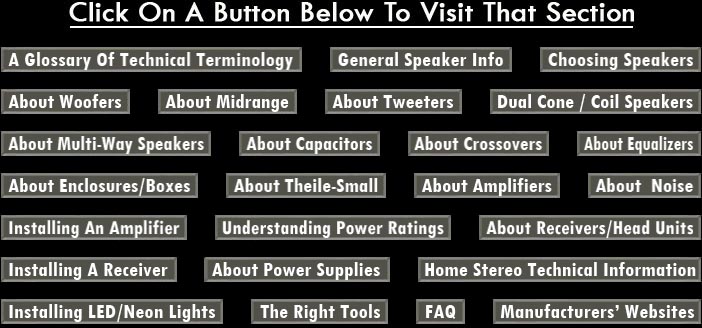


Radio Data System (RDS)
RDS stands for Radio Data System. RDS tuners can automatically tune in stations according to the types of music (or talk) they broadcast. RDS also enables a receiver to display text messages and even graphics (usually call letters and format information) that many FM stations include on a subcarrier signal within their normal broadcast signal. Some RDS equipped tuners can even override with traffic alerts or emergency broadcasts, during playback of other media - CD MD, or cassette. There are other useful features too, many of which are offered by the growing number of RDS stations
Radio Frequency (RF)
An alternating current or voltage with a frequency (or carrier wave) above about 100kHz. It's called radio frequency because these frequencies have a capacity to be radiated as electromagnetic waves by radio ( and television) stations.
Random Play
Also known as shuffle play. In CD players and changers, this function randomizes the order of selections during playback. Some CD players offer a "Random Play with Delete" feature that prevents a piece from being repeated once it has been played.
Random Code Encryption (or Varicode2 Transmitting System)
In auto security systems, these terms describe anti-code grabbing technology, a feature which prevents malicious persons who use a special receiver to intercept remote control codes, from using it to defeat the alarm.
Range (Audio)
Usually described as frequency range, this is a system's frequency transmission limits, beyond which the frequency is attenuated below a specified tolerance. Also, the frequency band or bands within which a receiver or component is designed to operate.
Rarefaction
In sound waves, the opposite of compression. An area of decreased air pressure caused by a sound wave. In a graphical depiction of a cyclical waveform rarefaction occurs when the wave is in the bottom segment. Sound is simply the alternating compression and rarefaction of air at varying and often overlapping frequencies, within a range to which humans are sensitive.
Ratio
One of the parameters which can be varied on dynamic range processors such as compressors and expanders. It represents the compression or expansion ratio between input and output levels. A compressor with a 2:1 ratio would reduce the output gain to half of the input value above the threshold. An expander with a 1:80 ratio would reduce the output gain to 1/80th of the input value below the threshold.
RE
The inherent Direct Current resistance of a speaker's voice coil.
Rem or Remote wire
The cable connected between the amplifier and the receiver that turns on the amplifier whenever the receiver is on. The receiver's connection supplies a 12 volt signal only, that may be used simultaneously to turn on such devices as an equalizer, amplifier, and to raise the antenna.
Remote Control
For remote-compatible devices, wired or infrared wireless remotes are either included with a receiver or CD player, or available as accessories. This enables the unit to be operated from the back seat or even outside the parked car.
Reactance
In Ac circuits, whether passive or active, a form of frequency dependent resistance produced by inductors. Such an inductive loading will allow all dc current to pass without change, but will attenuate various, mostly higher frequencies, depending on the nature of the coil.
Resistance
Most all conductors of electrons exhibit a property called resistance. Resistance impedes the flow of current. It is measured in units called Ohms. With a water hose, resistance could be regarded as friction between the water and the hose. A larger hose would create less friction and have a lower resistance than a smaller hose. In electrical circuits, small round cylinders with wires on either end are called resistors. These typically reduce the flow of electrons to serve the specific requirements of the circuit elements, such as amplification or switching functions.
Resonance
The tendency for a mechanical or electrical systems to vibrate or resonate sympathetically at a certain frequency when stimulated by external energy. Every element and material has a particular natural resonance point. The job of the speaker designer is to minimize these output peaks whenever they appear so that a smooth response is created.
Resonant Frequency
The frequency at which a speaker cone vibrates with the least inertia. The point on the spectrum at which it has the greatest amplitude relative to all other applied frequencies.
Reverb
Abbreviation for reverberation, a complex blend of multiple interacting reflections within an enclosed space which combines with the direct sound from a source and defines the character of the sound in a room or hall. It is also used for a signal processor which can generate an approximation of natural reverb. (Caution: do not confuse with 'Echo' - a different effect altogether.)
Reverberant Field
The sound field that exists when the reflected sound at a listening position predominates over the direct sound from the source. This contrasts with near field effects. Layout, reflectivity and spatial parameters will strongly influence the creation of this situation.
RF Modulator
A device that
converts a signal (typically audio and/or video) into a radio frequency. This can be received by a tuner and converted to perceptible information.
Ribbon Driver
The ribbon tweeter driver is a very thin corrugated aluminum "voice coil" hanging freely like a streamer in a side-by-side magnetic field. A ribbon is actually a type of dynamic driver, in which the voice coil is in the form of a flat, ribbon-shaped conductor which, positioned between opposite magnetic fields, actually becomes the diaphragm itself. The ribbon is free of the stretched film resonance's and obstructing magnets of the planar-magnetic, so it offers outstanding pulse response, uniform drive, and a good approximation of a line source, but the efficiency and impedance are both phenomenally low and the base technology is not usable as a woofer due to the small area. Most practical ribbons either use a step-down transformer or ask the amplifier to drive a A 1/2 ohm load (not a practical solution for most).
The ribbon cannot be used to produce low frequencies. To create a moving element large enough to generate frequencies lower than a few hundred Hertz would mean moving opposing magnetic poles so far apart that they no longer exert a sufficient magnetic field over the entire area of the ribbon. But, a ribbon offers very precise treble around, superior to dynamics or electrostatics.
In many ways, a ribbon driver can be an excellent performer: the moving element (the ribbon itself) is extremely light, allowing good speed and transient performance as well as freedom from coloration. They are however, expensive, and hard to find.
Ringing
The tendency for any vibrating surface to continue to produce the same frequency. This is limited by the decay time over which the inertia of other forces act to repress the motion. In acoustics, this tendency is known as reverberance. In human physiology, a condition called tinitus causes the sensation of ringing, which is actually a nerve disorder rather than a problem with the ear's mechanism.
Ripple (Amplifier)
A train of pulses that occurs when AC is changed to DC via a rectifier. These pulses are left on the DC if not filtered and regulated properly, or if toomuch current is being drawn.
Ripple (Speaker)
The maximum deviation from flat response, measured in decibels-it indicates the port's effect on woofer output.
RMS
Root Mean Square is a formula that provides a reasonably accurate means of measuring and comparing continuous AC power. The use of this measure is preferred when matching system components, like amplifiers and recievers. (see Power Handling)
Roll Off
A graduated reduction in the strength of audio output above and below certain specified frequencies. (See Crossover)
Roof-Mount Antenna
A permanently-installed antenna located in the center of a vehicle's roof.
Room Response
The effectiveness of any speaker system is a function of the room or environment in which it is played. The coupling of the speaker to the room or listening space is a function that is as critical as that between the woofer and the enclosure. When in doubt, experiment! This is the only practical method of achieving the optimal response form speakers in nearly any situation. Of course, computer modeling based on real time measurements could be substituted, albeit quite expensively.
Rotary Volume
An analog or linear volume control operated with a knob to raise and lower the volume, as opposed to separate digital "up and down" pushbuttons or pushbar.
Run-Length Encoding
See "Non-Lossy Compression."















